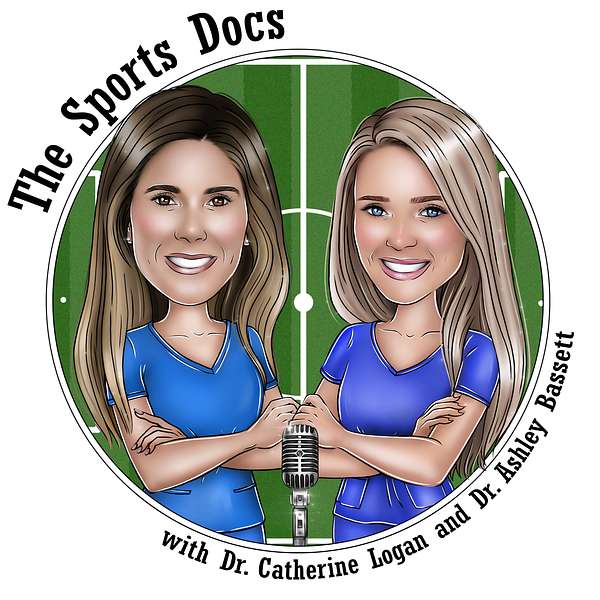
The Sports Docs Podcast
Sports medicine is a constantly evolving field, with hundreds of new articles published each month on the topic. This ever-growing wealth of information can make it challenging to stay updated on the newest approaches and techniques, and to know which data should actually change your practice. Join orthopedic surgeons, Dr. Catherine Logan and Dr. Ashley Bassett, as they chat about the most recent developments in sports medicine and dissect through all the noise.
On each episode of The Sports Docs podcast, the hosts will tackle a specific injury – from ACL tears to shoulder instability – and review the top research from various high-impact journals that month, including The American Journal of Sports Medicine, Arthroscopy: The Journal of Arthroscopic and Related Surgery, Sports Health, Journal of Shoulder and Elbow Surgeons, and more. The Sports Docs will also be joined by experts in the field of sports medicine – orthopedic surgeons, nonoperative sports medicine specialists, athletes, physical therapists, athletic trainers and others – to provide a fresh and well-rounded perspective based on their unique experiences.
The Sports Docs – Dr. Logan & Dr. Bassett – are friends & former co-residents from the Harvard Combined Orthopaedic Residency Program, who went onto esteemed sports medicine fellowships at The Steadman Clinic and The Rothman Institute, respectively. Dr. Logan practices in Denver, CO, and serves as Team Physician for Men's USA Lacrosse & as a Team Physician for U.S. Ski & Snowboard. Dr. Bassett is the director of the Women’s Sports Medicine Center at the Orthopedic Institute of New Jersey and practices across northern NJ, primarily in Morris and Sussex Counties.
Together, they will bring monthly conversations on how to care for athletes of all ages and levels of play, with a healthy mix of cutting-edge science and real-world application.
The Sports Docs Podcast
107: Advances in Medial Meniscus Root Repair with Dr. Aaron Krych (Part 1)
On today’s episode we’re focusing on medial meniscus root repairs with Dr. Aaron Krych, Chair of Orthopedic Surgery and Professor of Orthopedic Surgery at The Mayo Clinic in Rochester, Minnesota. We have some great articles for you that contribute well to our conversation on the optimal treatment of medial meniscus root tears, including recent advancements in surgical technique to optimize outcomes.
We’ll start off our discussion today with systematic review article from the February issue of Arthroscopy this year titled “Root Repair Has Superior Radiological and Clinical Outcomes Than Partial Meniscectomy and Nonoperative Treatment in the Management of Meniscus Root Tears.” This review included 56 studies with over 3000 patients. The authors concluded that root repair demonstrated the least amount of postoperative joint space narrowing and the greatest increase in patient reported outcome scores including IKDC, Lysholm, KOOS pain and activity scales.
Then, from the February 2022 issue of OJSM we review the publication titled “Prospective Consecutive Clinical Outcomes After Transtibial Root Repair for Posterior Meniscal Root Tears.” This multicenter case-control study concluded that patients who underwent posterior meniscus root repair utilizing a transtibial pullout technique had significant improvement in clinical outcome scores at 2 years with an overall low complication rate. Increased age, increased BMI, cartilage status, and meniscal extrusion did not have a negative impact on short-term functional outcomes, but age greater than or equal to 50 years and extrusion negatively influenced patient activity level.
We finish up our conversation today with the publication titled “Biomechanical Performance of TranstibialPull-Out Posterior Horn Medial MeniscusRoot Repair Is Improved With KnotlessAdjustable Suture Anchor–Based Fixation.” This controlled laboratory study, published in the March issue of OJSM this year, compared four different fixed transtibial pullout repair techniques to a knotless adjustable repair technique. If you are watching this on YouTube you will be able to see the different suture configurations that were compared. Otherwise, check our social media for images! This study found that the knotless adjustable repair resulted in higher tissue compression and less tissue displacement compared to traditional fixed repair, which is great for healing. Additionally, the rip-stop Mason-Allen suture configuration provided higher resistance to suture cut-through, withstanding repair failure.
We are joined today by Dr. Aaron Krych, Chair of Orthopedic Surgery and Professor of Orthopedic Surgery at the Mayo Clinic. He is also the Chair of the Division of Sports Medicine at Mayo Clinic and team orthopedic surgeon for Minnesota Timberwolves. Dr. Krych received his medical degree and completed his orthopedic surgical residency training at the Mayo Clinic. He then went on to complete a fellowship in sports medicine at the Hospital for Special Surgery. Dr. Krych has published extensively on the topic of meniscal pathology, and specifically meniscus root repair, so we are very excited to have him join our discussion today.